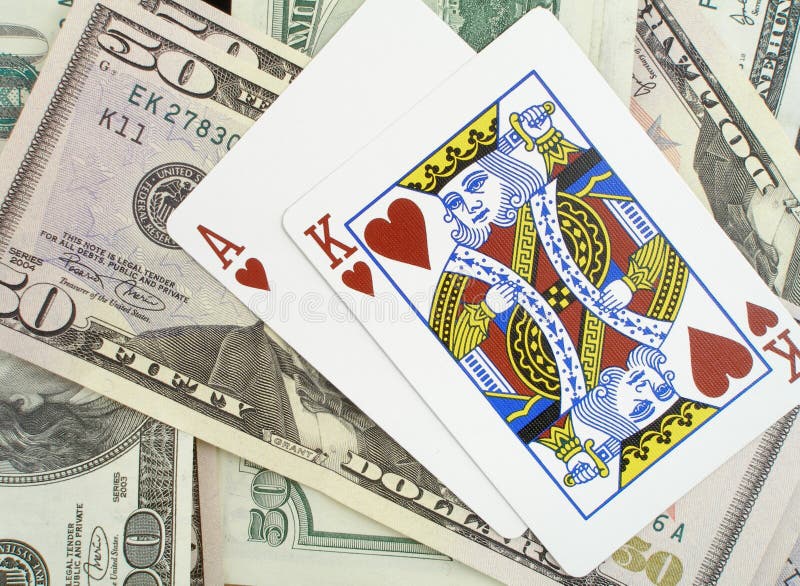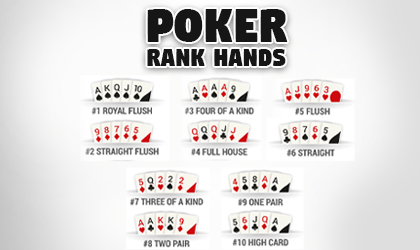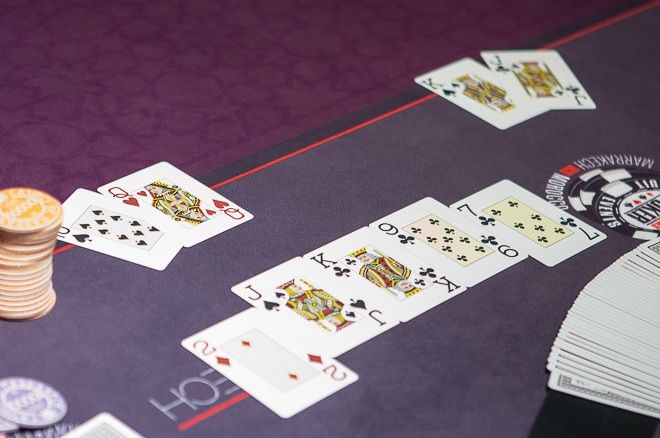 Simply Scheme
Simply SchemePoker Straight Rules King Ace Two Seater
:
A straight is five cards that all connect – five cards in a row, such as 7-6-5-4-3. When two or more players hold a straight, the hand with the highest starting card wins, thus a Jack-high straight (J-10-9-8-7) beats a five-high straight (5-4-3-2-A) even though the five-high contains an ace. A - hearts Q - hearts J - hearts 6 - hearts 3 - hearts This would be an Ace-High Straight (very strong) Full House - having a pair, AND 3 of a kind at the same time ex. J, J, Q, Q, Q The Jacks would be your pair, and the Queens your 3 of a kind (also known as Jacks over Queens or a Full-Boat) Four of a Kind - having four cards with same face. Ten, Jack, Queen, King, and Ace are often abbreviated T, J, Q, K, and A, respectively, so that each card name has a single number or letter associated with it. This is commonly used in describing hands, for example, A-2-3-4-5 is a hand with an ace, a two ('deuce'), a three, a four, and a five — not necessarily in that order, but presenting them in that order makes it clear that the hand is a straight. I once played pai-gow poker, A pit game where your playing against the house, I had a king high straight, the dealer had a wheel, they said the wheel won because it was ace high. I just left and never played the game again. In home games and casino table games you may want clarify. – Jon Nov 21 '14 at 6:43. This is the system often used in home poker games, straights and flushes count, and aces are low cards. Under Ace-to-6, 5-4-3-2-A is a bad hand because it is a straight. The best low hand is 6-4-3-2-A. Since aces are low, A-K-Q-J-10 is not a straight and is considered king-down (or king-low). Ace is low card so K-Q-J-10-A is lower than K-Q-J-10-2.
Introducing Computer SciencePoker Straight Rules King Ace Two Kids
2/e Copyright (C) 1999 MIT
|
The idea of this project is to invent a procedure poker-valuethat works like this:

As you can see, we are representing cards and hands just as in theBridge project, except that poker hands have only fivecards.[1]
Here are the various kinds of poker hands, in decreasing order of value:
| • | Royal flush: ten, jack, queen, king, and ace, all of the same suit |
|---|
| • | Straight flush: five cards of sequential rank, all of the same suit |
|---|
| • | Four of a kind: four cards of the same rank |
|---|
| • | Full house: three cards of the same rank, and two of a second rank |
|---|
| • | Flush: five cards of the same suit, not sequential rank |
|---|
| • | Straight: five cards of sequential rank, not all of the same suit |
|---|
| • | Three of a kind: three cards of the same rank, no other matches |
|---|
| • | Two pair: two pairs of cards, of two different ranks |
|---|

| • | Pair: two cards of the same rank, no other matches |
|---|
| • | Nothing: none of the above |
|---|
An ace can be the lowest card of a straight (ace, 2, 3, 4, 5) orthe highest card of a straight (ten, jack, queen, king, ace), but a straightcan't 'wrap around'; a hand with queen, king, ace, 2, 3 would be worthless(unless it's a flush).
Notice that most of the hand categories are either entirely about the ranksof the cards (pairs, straight, full house, etc.) or entirely about thesuits (flush). It's a good idea to begin your program by separating therank information and the suit information. To check for a straight flush orroyal flush, you'll have to consider both kinds of information.
In what form do you want the suit information? Really, all you need is atrue or false value indicating whether or not the hand is a flush, becausethere aren't any poker categories like 'three of one suit and two ofanother.'
What about ranks? There are two kinds of hand categories involving ranks: the ones about equal ranks (pairs, full house) and the ones about sequentialranks (straight). You might therefore want the rank information in twoforms. A sentence containing all of the ranks in the hand, in sorted order,will make it easier to find a straight. (You still have to be careful aboutaces.)
For the equal-rank categories, what you want is some data structure thatwill let you ask questions like 'are there three cards of the same rankin this hand?' We ended up using a representation like this:
One slightly tricky aspect of this solution is that we spelledout the numbers of cards, one to four, instead of using the moreobvious (1 Q 2 3 2 4). The reason, as you can probably tell just bylooking at the latter version, is that it would lead to confusion betweenthe names of the ranks, most of which are digits, and the numbers ofoccurrences, which are also digits. More specifically, by spelling out thenumbers of occurrences, we can use member? to ask easily if there isa three-of-a-kind rank in the hand.
You may find it easier to begin by writing a version that returns only thename of a category, such as three of a kind, and only after you getthat to work, revise it to give more specific results such as threesixes.
Extra Work for Hotshots
In some versions of poker, each player gets seven cards and can choose anyfive of the seven to make a hand. How would it change your program if theargument were a sentence of seven cards? (For example, in five-card pokerthere is only one possible category for a hand, but in seven-card you haveto pick the best category that can be made from your cards.) Fix yourprogram so that it works for both five-card and seven-card hands.
Another possible modification to the program is to allow for playing with'wild' cards. If you play with 'threes wild,' it means that if there isa three in your hand you're allowed to pretend it's whatever card you like.For this modification, your program will require a second argument indicatingwhich cards are wild. (When you play with wild cards, there's thepossibility of having five of a kind. This beats a straight flush.)
 [1] Later on we'll think about seven-card variants of poker.
[1] Later on we'll think about seven-card variants of poker.BACKchapter thread NEXT
Brian Harvey,bh@cs.berkeley.edu